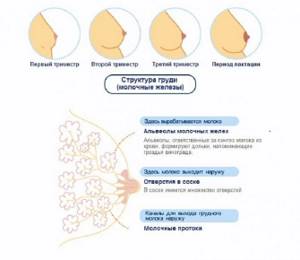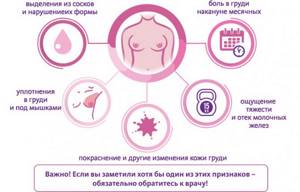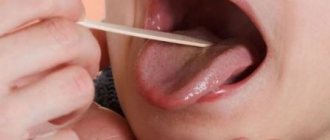Immediately after the moment of conception or fertilization of the egg, changes begin in the female body, which directly affect the mammary glands. Soreness appears, the process of swelling occurs - this is all the work of two types of hormones - progesterone and prolactin, which are rightfully considered pregnancy hormones.
Sometimes a pregnant woman notices that her breasts no longer hurt early in pregnancy, and this causes anxiety and makes the expectant mother nervous.
But this phenomenon is not always negative. You just need to have a good understanding of the internal processes taking place and be able to analyze your state. And in any case, a consultation with a gynecologist-obstetrician will not be a hindrance.
Why does a woman have breast pain?
Discomfort indicates not only diseases of the mammary glands, but also pathologies of organs close to the chest.
Why women's breasts may hurt:
- Hormonal changes depending on the menstrual cycle: ovulation, premenstrual syndrome, delayed menstruation.
- Pregnancy, changes in tissue structure.
- During lactation - lactostasis.
- Menopause.
- Mastopathy, cancer, fibroadenoma.
- Trauma - blows, falls, bruises.
- Uncomfortable bra.
- Pathologies of the heart, stomach, lungs, bronchi, nerves.
- Problems with the musculoskeletal system.
- Infectious inflammatory processes, mastitis.
- Thyroid diseases.
The following are considered the norm:
- pain during puberty, when the body undergoes restructuring during growth;
- discomfort in the mammary glands before 12-15 weeks of pregnancy, caused by stretching of the skin, enlargement of the milk ducts;
- cyclical pain (before menstruation, during ovulation - preparing the body for bearing a fetus).
What conditions and diseases of women also cause pain in the mammary glands?
- Treatment with hormonal drugs for infertility or hormonal imbalance of the menstrual cycle, menopause.
- Very large breast size; Tight underwear that does not match your breast size.
- Other diseases that cause pain radiating to the mammary glands are herpes zoster, thoracic osteochondrosis, heart disease, intercostal neuralgia, diseases of the lymph nodes of the axillary areas, cysts in the fatty tissue of the breast, furunculosis.
- Taking certain oral contraceptives.
In case of unpleasant symptoms and pain in the mammary glands, which continue for a long time and are accompanied by additional pathological symptoms, a woman should definitely contact her treating gynecologist, who, if necessary, will refer her for consultation and examination with a mammologist and endocrinologist.
Examinations that a woman undergoes for pain in the mammary glands not related to pregnancy:
- Ultrasound of the pelvic organs, which is performed a week after the start of menstruation.
- Study of hormonal levels (thyroid hormones, prolactin).
- Oncological markers (a set of diagnostic procedures to identify the degree of risk of developing cancer tumors in the mammary gland).
- Ultrasound of the breast, which is performed in the second half of the menstrual cycle.
Point pain in the chest in women
Point mastalgia of an acute local nature. Usually one gland hurts, most often the discomfort manifests itself when pressed. If the patient is under 40 years old, and the doctor has not detected any changes in the gland, the symptom can be considered harmless; it occurs against the background of severe stress, nervous worries, and lack of sex.
At the initial manifestation of discomfort, it is recommended to take drugs such as nitroglycerin or validol, since local pain often indicates heart problems.
Call an ambulance immediately if:
- The vision becomes dark, speech is confused, consciousness is lost.
- Validol and nitroglycerin did not drown out the painful sensations.
- Weakness and lethargy throughout the body, difficulty moving.
The causes of point mastalgia are varied:
- disruptions in the functioning of the cardiovascular system, myocardial infarction;
- benign breast lesion;
- inflammation during the period when a woman is breastfeeding;
- stagnation of milk in the ducts of the mammary glands;
- tumor of glandular origin;
- infections, inflammations;
- accumulation of excess fluid in tissues.
A woman feels a pinpoint pain that is caused by pressure, or inside the gland without mechanical intervention, and which does not go away within several days - you need to consult a mammologist, oncologist or gynecologist.
A dangerous symptom is if, during an examination, the doctor feels a lump - this may indicate cancer (not always). A biopsy of dense tissue is prescribed.
The doctor can conduct a complete blood test with ESR, do an ultrasound, mammography, radiological examination - the examination regimen is selected by a medical professional. Treatment depends on the diagnosis.
When the mammary glands swell in a pregnant woman: symptoms at 1-4 weeks
Breast enlargement and pain are observed in women at different periods of their lives. This is not necessarily related to pregnancy. So, it could be menstruation or ovulation, as well as various internal pathologies, which the body signals in this way and which is why the breasts swell and discomfort appears in this part of the body.
The difference lies only in the sensations and their duration. So, after menstruation, within a few days everything returns to normal and pain symptoms usually disappear. Ovulation also causes swelling of the mammary glands, but this goes away over the next 1-2 days.
If fertilization has occurred, the symptoms and sensations will be different. Even if the test is negative, which the girl conducted due to lack of menstruation at the appointed time, then the body will tell her about her new condition.
The first week does not differ in any special changes and usually women do not even realize that they are pregnant. Sometimes the stomach feels tight, which is why they always wait for their periods, believing that they are just late.
Starting from the second week, the body begins to “talk” to the woman, helping her understand that a new life has arisen in her womb. The chest begins to itch, the stomach and nipples hurt slightly. At this time, the lobules of the mammary glands become dense, so breast sensitivity increases noticeably.
In the third week, the hormones progesterone and estrogen come into play. This is the very moment when in the early stages you can understand without tests that conception has occurred. The breasts become very full and sore, the nipples become sensitive, peel, and the halos around them become dark in color.
The fourth week is characterized by active release of the hormone progesterone. At the same time, roughness and stretch marks may be observed around the nipples. In the first trimester, symptoms associated with the mammary glands, as well as toxicosis, are most pronounced.
By the beginning of the fourth month they become noticeably weaker. At the end of the first and beginning of the second trimester, colostrum production may begin, which is accompanied by discomfort in the chest area and nipple discharge.
How classical music can help relieve pain
Classical music has a beneficial effect on the nervous system. During the Soviet era, it was discovered that when cows listened to classical works, their milk yield increased.
Classic melodies improve memory, increase intelligence, and can heal and relieve pain. You need to choose a suitable melody.
Each diagnosis has its own version of the work:
- F. Schubert “Ave Maria” - to improve blood composition.
- F. Mendelssohn “Wedding March” from the 5th symphony – liver disease, hepatitis.
- Works by J. Bach - difficulties with the musculoskeletal system.
The main condition for relieving pain through music is the patient’s easy perception of the melody.
What does dull, pulling, pinpoint, aching or cutting pain in the chest indicate?
Breasts hurt during menstruation because hormonal levels change and temporary changes occur in the body. The condition is not always physiological, often it is a symptom of a disease, the beginning of a pathology.
To find out why the pain appears, they consult with a therapist, who refers the patient to specialists after conducting laboratory and instrumental tests.

During menstruation, the outer layer of the uterine lining is shed. This results in slight physiological bleeding. The condition is formed due to the restructuring of hormones so that the body prepares for conception.
Due to temporary changes in hormonal levels, the volume of the mammary glands increases. But this happens insignificantly, so it is visually invisible.
Some women complain of tingling. This is a normal condition if it goes away immediately after your period ends. When discomfort persists, they look for illness.
Causes of dull chest discomfort:
- mechanical damage, injuries that violate integrity;
- angina pectoris, pre-infarction condition;
- gastritis, increased acidity, stomach ulcer (the syndrome spreads to neighboring formations, so abdominal and chest pain is felt);
- pathologies localized in the respiratory tract (tracheitis, bronchitis, pneumonia, emphysema, tuberculosis);
- neurological diseases (pinching, mechanical damage, inflammation of the nerves running from the spine to the periphery);
- diseases of the musculoskeletal system.
Damage to the spine and nerve tissue extending from it is often observed.
The following types of diseases are formed:
- Osteochondrosis. The vertebrae gradually wear out, the volume of intervertebral discs decreases, and nerve tissue is pinched. The pain radiates to the shoulder, shoulder blade, and chest.
- Intercostal neuralgia. Fibers are pinched when posture is bent, scoliosis. Pinching occurs due to displacement of the vertebrae and ribs. The pain is similar to symptoms of cardiovascular disorders. But taking pills for blood vessels and normalizing blood flow will not help.
Causes of pulling sensations:
- complications after surgery on the mammary glands or surrounding areas;
- postpartum condition, for example, when excess milk appears;
- blockage of glands with compaction from breast milk;
- inflammation of the glands, nipples (mastitis formed due to narrow ducts or accumulation of milk);
- benign tumors (fibroadenoma);
- mastopathy – growth without malignant neoplasms;
- breast enlargement during pregnancy.
Factors causing pinpoint, aching painful sensations:
- blockage of blood vessels, capillaries;
- the onset of inflammation;
- mechanical injury;
- wearing uncomfortable underwear;
- small tumors of a benign or malignant nature that gradually begin to grow.
If a cutting feeling develops, a person should be wary. The condition does not occur normally. It does not occur during premenstrual syndrome, ovulation, or menstruation. This is a sign that manifests itself in diseases and injuries. Often formed due to mechanical damage to the gland, skin, nipples.
Pain as a normal option
It happens that your breasts hurt very badly before your period, and thoughts already arise that the reason is very serious. But this may be mastodynia - pain in the mammary glands that occurs for natural reasons during PMS.

Typically, breast tenderness in such cases is accompanied by additional symptoms:
- frequent mood changes;
- irritability;
- feeling tired;
- nagging pain in the lower abdomen;
- swelling and some others.
Approximately 70% of women are concerned about this problem. Pain can appear both at a young age and in more mature women. This can be called payment for the opportunity to have children. Every month there are cyclical changes in hormonal levels, which are accompanied by not very pleasant symptoms. All this is not dangerous and goes away when menstruation begins.
If, however, the burning sensation in the chest before menstruation is very disturbing, accompanied by heavy discharge during menstruation and an unstable cycle, you can consult a gynecologist.
He will select hormonal contraceptives. Mastodynia is treated by taking these drugs.
When you need to see a doctor urgently
It is not always necessary to contact a therapist when signs of discomfort appear. More often, the symptom occurs against the background of hormonal changes during PMS, ovulation, pregnancy, lactation, menstruation and will go away on its own over time. If you are concerned about severe pain, for example, during menstruation, use mild painkillers.
You should consult a doctor if the following additional symptoms appear:
- irradiation to neighboring areas (abdomen, back, shoulders, shoulder blades);
- temperature increase;
- clear, white, purulent discharge from the nipples;
- seals inside the glands;
- sharp, cutting pain that cannot be tolerated;
- a sharp deterioration in health, malaise, fainting;
- soreness that does not go away over time.
With any symptom, contact a therapist or gynecologist.
They refer for the following types of examinations:
- general blood and urine analysis - reveal the function of the circulatory and lymphatic systems;
- biochemical test - determination of the amount of transaminases;
- coagulogram - determination of coagulation activity;
- biopsy with histology - normal, benign, malignant cellular composition is detected;
- mammogram;
- chest x-ray;
- study of tumor markers.
If the examinations are inconclusive, MRI is used. It shows the image of organs on the screen layer by layer. It becomes clear where the pathology of blood vessels, nerves, muscles, ligaments, tendons, and bones is formed.
After receiving information and suggesting a diagnosis, the patient is sent to specialists. These include a neurologist, cardiologist, phlebologist, endocrinologist, and oncologist.
Top medications to reduce pain
The definition of pain medication depends on the symptoms and the disease causing the symptom.
There are indications and contraindications; not all medications are well tolerated:
- Antispasmodics. Prescribed for spasms of smooth muscles. They lead to a narrowing of the lumen of the vessel, reducing muscle soreness. They use Spazmalgon, Spazgan. They have few side effects and contraindications and are well tolerated. Not recommended during pregnancy and lactation.
- Non-steroidal anti-inflammatory drugs. These are analgesics that eliminate pain, inflammation, and fever. The effect occurs when the activity of prostaglandins is suppressed. These are the drugs of choice; there is no dependence on them. Activation occurs quickly, within 30 minutes. There are many side effects and contraindications. Not recommended for use for more than 10-14 days. They use Ketanov, Dexalgin, Diclofenac. They are taken in tablets or injections. The second form is preferable for excessively severe pain accompanied by hyperthermia. The injections have less effect on the gastrointestinal tract and act faster.
- Analgesics. Most of them have antipyretic activity, reducing body temperature. Pharmacodynamics occurs due to the suppression of prostaglandin function, influencing the thermoregulation center in the hypothalamus. Paracetamol is often used. It eliminates pain in the head, teeth, and is useful for neuralgia, myalgia, and algodismenorrhea. Side effects and contraindications are minor. Well tolerated by patients. Allowed in the 3rd trimester of pregnancy.
- Opioid analgesics. The function of the central nervous system is suppressed. The pain impulse is not perceived, reflexes are inhibited. They use Promedol, Tramadol. They are used only with a prescription; without it, sale in pharmacies is not available. The tablets have many contraindications for use and negative effects. The effect does not last long, the discomfort completely disappears. Drowsiness and decreased concentration are observed. Substances are used only in emergency situations.
When using pain medications, it is important to understand that they do not treat the underlying cause of your symptoms. Suppression of the pain symptom occurs for a while, then it occurs again.

Additionally, drugs are used to treat the underlying cause:
- medicinal components based on hormones (estrogens, progesterones);
- herbal medicines that normalize lactation (Mastodinon);
- antianginal medications that restore the condition of blood vessels, preventing attacks of angina (nitrates, beta-blockers, calcium agonists).
In some cases, medications do not help. For example, for benign and malignant tumors, injuries. Consult with a surgeon about the operation. But for the preparation and subsequent rehabilitation period, an additional list of drugs is prescribed.
Preventive measures
Not every woman wants to wait until things get worse.
Therefore, preventive measures have been developed aimed at preventing diseases:
- Wearing a comfortable bra. It is selected according to size. If it is smaller, the chest is compressed. This is a favorable environment for the development of tumors, injuries, muscle spasms, and lactostasis. Large size leads to sagging and painful sensations.
- Visit to the gynecologist. They come for inspection every year. Laboratory tests are required to understand the functional state of the uterus, ovaries, tubes, vagina, and mammary glands. They are all interconnected.
- Mammogram. It is carried out annually; tumor cells can multiply at any time, growing quickly. The images show normal tissue or early manifestations of compactions. The procedure is contraindicated for women during pregnancy and lactation, as radiation is released during the process.
- Eating quality food. Vitamins, microelements, and minerals that are beneficial for internal organs should be supplied. If there are not enough of them, your health worsens. Laboratory analysis is performed to identify missing substances. According to his data, multivitamins are selected.
- Physical activity. If it is insufficient, muscles weaken and systemic blood flow deteriorates. Nutrients and oxygen reach the organs, including the mammary gland, in a smaller volume.
- Rational use of contraceptives. To ensure adequate use of contraceptive drugs, tests are taken beforehand. They are not available for patients with elevated platelets and coagulation elements. It is prohibited to drink them without the approval of a gynecologist.
- Proper breastfeeding. If the patient does not know how this is done, it is better to clarify this with a feeding specialist. After each feeding, there should be no milk left in the right and left breasts. If the baby does not suck all the colostrum completely, you need to express it. Otherwise, lactostasis will form.
- Hygiene procedures. Keep the body clean to avoid infectious and inflammatory processes. Bacteria often penetrate through the nipples into the glands, especially during pregnancy and lactation.
Preventive measures will not be able to completely protect the patient from the occurrence of sudden pathologies, but they reduce their possibility. They are guided not just once, but throughout life.
If a woman is at risk, she undergoes laboratory and instrumental examinations more often. For example, when a benign tumor forms, the blood is periodically checked for the presence of tumor markers in order to identify the beginning of a malignant process.
Breast stretch marks. How to fight and reduce unwanted consequences?
Often, with breast enlargement, a venous pattern appears, but you should not be afraid of this, since later, when the breasts return to their previous size, the pattern will not be noticeable.
But often, after such a sharp breast enlargement, stretch marks appear. It is associated with changes in breast weight during pregnancy and lactation. Stretch marks are also very common in adolescence. When a girl experiences a dramatic development of the mammary glands and her breasts rapidly grow to size 2-3. At its core, any sudden increase or decrease in breasts leads to the appearance of stretch marks.
Stretch marks appear due to loss of tissue elasticity, so creams aimed at maintaining the proper level of hydration and nutrition for the breast area are effective.
It is also possible to choose special remedies for stretch marks (stretch marks) during pregnancy.

A comfortable bra during pregnancy is the key to healthy breasts
How to combat the appearance of stretch marks or make them less noticeable during pregnancy:
- Always wear a comfortable bra that does not compress or interfere with blood circulation.
- Apply moisturizing oils and lotions to the skin.
- Take a shower and massage the chest area (but not the nipples, so as not to cause uterine tone.)

The cream will help fight breast stretch marks
A more radical method to combat stretch marks is mesotherapy. These are injections that are made on the basis of collagen, vitamins and acids that activate skin regeneration and hydration. This procedure is carried out after feeding, when the body begins to rebuild itself again to its previous state. These procedures are done in cosmetology clinics, and mesotherapy is often prescribed along with special peelings and masks for the décolleté and chest area.
Also, to prevent the appearance of stretch marks, oils are used that help moisturize the skin and give it elasticity. The oil should be quickly absorbed and not leave a sticky or greasy film on the surface of the breast. Since the skin during pregnancy needs breath and freshness. Starting from the second trimester, it is recommended to carry out a contrast shower on the chest and décolleté area, but at the same time pay close attention to the temperature of the water; it should not be very hot or very cold. Since during pregnancy, the breasts must be protected from both overheating and hypothermia.
What does sudden pain mean?
The formation of negative feelings during ovulation, menstruation, and pregnancy is a normal physiological process. There's no need to worry about this. The sensations are not sharp, but pulling. They bring a slight loss of strength, but the state of health does not deteriorate significantly.
The appearance of an acute, cutting pain syndrome, radiating to neighboring areas, indicates the formation of the disease. Monitor their condition. If it does not improve within 2-3 days, consult a doctor.
Patients often confuse the conditions, fearing for their lives. For example, a sudden attack of intercostal neuralgia with angina pectoris and myocardial infarction.
They call an ambulance and do different types of tests. It is better to consult a therapist in a timely manner than to miss a life-threatening alarming condition.










